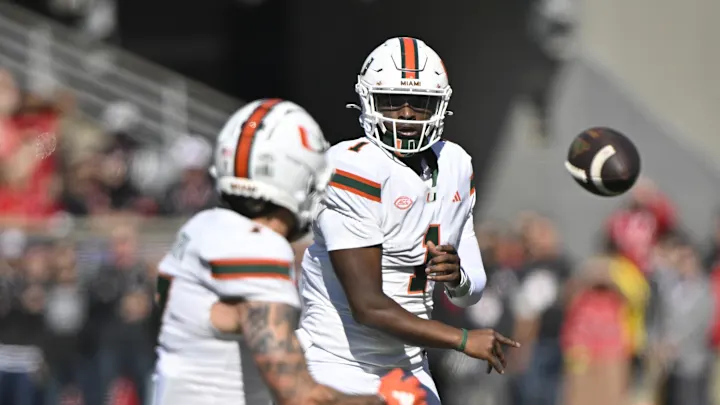In the ever-intensifying landscape of college football recruiting, the Miami Hurricanes faced a significant setback as they lost out in the competition for a coveted 4-star wide receiver to the Florida State Seminoles and the Florida Gators. This loss adds to the mounting challenges Miami has encountered in recent recruiting cycles and raises questions about the program’s current trajectory and recruiting strategy. The wide receiver in question, regarded as one of the top prospects in his class, ultimately chose to stay in-state but bypassed the Hurricanes in favor of their Atlantic Coast Conference and Southeastern Conference rivals.
For years, Miami has been a beacon of football excellence in the Sunshine State, historically dominating the recruiting scene with its rich tradition, prime location, and legacy of producing NFL talent. However, recent years have seen Florida State and Florida begin to close the gap significantly, both on the field and in recruiting battles. This particular recruitment saga highlights that shift in momentum and underscores the increasingly competitive nature of recruiting among the three programs.
The 4-star wide receiver, who boasts a combination of size, speed, and route-running ability, was highly sought after by several top programs nationally. His recruitment was a marquee battle not just because of his talent but also because of his regional ties. Miami’s staff believed they had a strong chance due to proximity and the program’s storied history, but Florida State and Florida each brought unique appeals to the table that ultimately swayed the young athlete.
Florida State’s recruiting pitch focused heavily on their recent resurgence under their current coaching staff. The Seminoles have reestablished themselves as a force in the ACC and have made significant strides in player development and offensive innovation. The coaching staff’s vision for how the wide receiver would fit into their offensive scheme, coupled with promises of early playing time and a clear path to becoming a focal point in their offense, proved compelling.
Meanwhile, the University of Florida leveraged its SEC status and national visibility. Florida’s coaching staff emphasized the program’s recent successes, access to high-level competition week in and week out, and the broader exposure players receive from competing in arguably the nation’s premier football conference. The Gators’ ability to attract NFL scouts and media attention was an important factor that resonated with the wide receiver and his family. Florida’s staff also highlighted their facilities upgrades and support system, painting a picture of an elite environment for the development of young athletes.
Miami, on the other hand, has struggled to regain its former recruiting dominance. The Hurricanes have faced instability within their coaching ranks, inconsistent on-field results, and occasional difficulties in connecting with recruits and their families on a personal level. While the program has landed some key prospects, losses like this one demonstrate that the competition for top talent remains fierce and that Miami must continue to adapt and evolve to stay relevant.
The wide receiver’s commitment decision has ripple effects beyond just the 2025 recruiting class. It signals a potential shift in Florida’s recruiting landscape, where the traditional power balance among the three major programs is more fluid than ever. Florida State’s ability to win key recruitments against Miami and other schools shows they are reestablishing their foothold in the state. Florida’s win further cements its status as a prime destination for elite talent, while Miami faces increased pressure to find new strategies to lure top prospects.
Recruiting is about more than just the immediate win or loss of a single player. It affects team chemistry, future recruiting cycles, and the overall perception of a program. Prospective recruits and their families watch closely how programs compete for talent. When a program consistently loses battles to rivals, it can lead to a perception of decline, which becomes a self-fulfilling prophecy unless actively addressed.
For Miami, the key challenge now is to analyze what went wrong in this recruitment and others like it. Were there gaps in the communication with the player or his family? Was the offensive scheme or vision unclear or less appealing than the alternatives? Did Florida State and Florida simply present a more compelling case with stronger relationships and a clearer path to success? Identifying these factors will be essential for Miami’s recruiting staff as they seek to rebound and recapture their position atop the Florida recruiting hierarchy.
Moreover, the Hurricanes will need to lean on their strengths—Miami’s rich history, the allure of playing in South Florida, and their proven track record of producing NFL-caliber wide receivers—to convince future recruits that they remain a premier destination. Investments in coaching continuity, player development, and facilities will also be critical. Enhancing the overall player experience—on and off the field—will be vital in swaying the next generation of talent.
Florida State and Florida, meanwhile, will look to capitalize on this victory. For the Seminoles, this win further validates their recruiting approach and signals that they are serious contenders not only on the field but also in talent acquisition. For the Gators, this reinforces their standing as an SEC powerhouse with deep roots in Florida recruiting. Both programs will continue to push aggressively to solidify their footing in the state.
As recruiting continues to evolve, the competition for players within Florida will remain among the fiercest in college football. Miami’s loss in this battle for a 4-star wide receiver serves as a reminder that no program can rest on its laurels, especially in a state that produces an abundance of football talent. Miami will need to retool, refocus, and recommit to the recruiting grind if they hope to reclaim their status as the dominant football program in the region.
This particular wide receiver will now join the ranks of Florida State or Florida, where he is expected to make an immediate impact. Both programs anticipate that his presence will bolster their receiving corps and provide a dynamic weapon in their offensive arsenals. For Miami fans, however, this is a bitter pill to swallow and a call to action for the Hurricanes’ coaching staff.
In the broader context, this recruitment battle reflects the shifting dynamics of college football recruiting nationwide, where talent distribution is less predictable, and traditional powerhouses must compete harder than ever. Miami’s path forward will depend on their ability to innovate and reconnect with prospects, leveraging their unique advantages while addressing the deficiencies exposed in battles like this one.
The 4-star wide receiver’s choice is a milestone moment in this ongoing saga—a reminder that recruiting is a complex, multi-faceted process shaped by relationships, vision, and opportunity. For Miami, this is a setback, but also an opportunity to learn and grow. The Hurricanes’ future success hinges on how well they respond to challenges like this and continue to fight for the best talent in the state and beyond.



